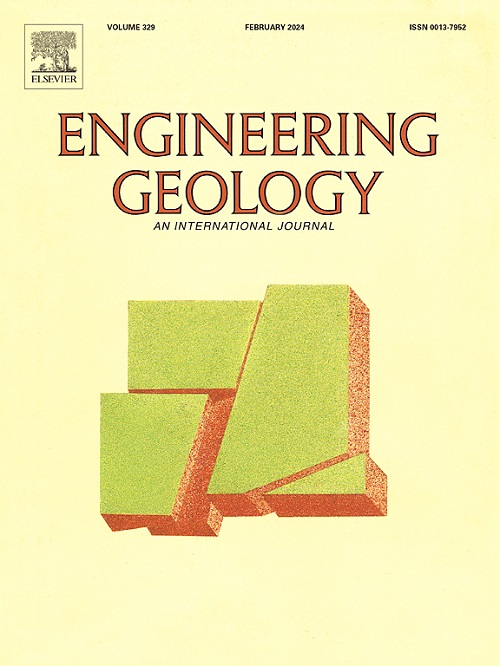Permeability of granitic drill core tested by steady flow and transient flow gas permeameter probes: Improvements to methods and applications
IF 6.9
1区 工程技术
Q1 ENGINEERING, GEOLOGICAL
引用次数: 0
Abstract
The permeability of undeformed, deformed and/or altered granites (Toki, Inada), and artificial porous ceramics, were tested by gas-probe permeameters (steady-state gas flow and transient pressure-pulse). The gas leak evaluation is essential in such tests. Here we demonstrate that stabilized apparent permeability vs. applied load does not guarantee no-leak condition, but the gas leaks are effectively prevented by an applied epoxy-resin seal-ring around each planned test spot, including on rough and vuggy rocks. The steady-state gas flow and the transient pressure pulse-decay tests show very close agreement in permeability results, if the differential test pressures and gas flow rates are approximately the same. The permeabilities begin to differ if the pressures do not match resulting from non-Darcy gas flow effects that depend on the gas flow rate. The pressure-decay test is analyzed at small data segments to show the change of apparent permeability with differential pressure (from non-Darcy to Darcy regime). In tests on rocks of low permeability, the correction for environmental temperature variation is simple to implement. For rocks with permeability larger than about 10−17 m2, the temperature variation does not affect the flow regime and no corrections need to be applied. Gas cooling due to depressurization did not significantly affect the transient pressure pulse-decay test results from later-time analysis of test data as low injection pressures are commonly used in pulse tests. However, impacts on early time data analysis need to be considered. The results of the absolute permeability from pressure-decay gas probe tests are matching published water-based permeameters within a half order of magnitude, which is within the uncertainty of these published data. On low-permeability granite, wider tests spots are better at testing the few dominant microfracture conduits than small spots. With appropriate probe-rock sealing methods and corrections, the probe-gas tip permeameter has been shown to correctly measure permeability in granite down to 10−20 m2 absolute permeability.
用稳定流动和瞬态流动气体渗透探头测试花岗岩岩心渗透率:方法和应用的改进
采用气体探针渗透率仪(稳态气体流量和瞬态压力脉冲)测试了未变形、变形和/或蚀变花岗岩(Toki, Inada)和人工多孔陶瓷的渗透率。气体泄漏评价在此类试验中至关重要。在这里,我们证明了稳定的表观渗透率与施加的载荷并不能保证无泄漏的条件,但是在每个计划的测试点周围施加环氧树脂密封圈可以有效地防止气体泄漏,包括在粗糙和洞穴岩石上。如果差压测试压力和气体流速近似相同,稳态气体流量和瞬态压力脉冲衰减测试在渗透率结果上非常一致。如果压力不匹配,则渗透率开始不同,这是由非达西气体流动效应造成的,这取决于气体流速。对小数据段的压力衰减试验进行分析,以显示视渗透率随压差(从非达西状态到达西状态)的变化。在低渗透岩石试验中,对环境温度变化进行校正比较简单。对于渗透率大于约10−17 m2的岩石,温度变化不影响流态,不需要进行修正。由于脉冲试验中通常使用低喷射压力,因此减压引起的气体冷却对试验数据后期分析的瞬态压力脉冲衰减试验结果没有显著影响。但是,需要考虑对早期数据分析的影响。压力衰减气体探头测试的绝对渗透率结果与公布的水基渗透率在半个数量级内相匹配,这在这些公布数据的不确定性范围内。在低渗透花岗岩上,较宽的测试点比较小的测试点更适合测试少数优势微裂缝导管。通过适当的探针岩石密封方法和校正,探针气体尖端渗透率仪已被证明可以正确测量花岗岩的渗透率,绝对渗透率低至10 - 20 m2。
本文章由计算机程序翻译,如有差异,请以英文原文为准。
求助全文
约1分钟内获得全文
求助全文
来源期刊

Engineering Geology
地学-地球科学综合
CiteScore
13.70
自引率
12.20%
发文量
327
审稿时长
5.6 months
期刊介绍:
Engineering Geology, an international interdisciplinary journal, serves as a bridge between earth sciences and engineering, focusing on geological and geotechnical engineering. It welcomes studies with relevance to engineering, environmental concerns, and safety, catering to engineering geologists with backgrounds in geology or civil/mining engineering. Topics include applied geomorphology, structural geology, geophysics, geochemistry, environmental geology, hydrogeology, land use planning, natural hazards, remote sensing, soil and rock mechanics, and applied geotechnical engineering. The journal provides a platform for research at the intersection of geology and engineering disciplines.
 求助内容:
求助内容: 应助结果提醒方式:
应助结果提醒方式:


